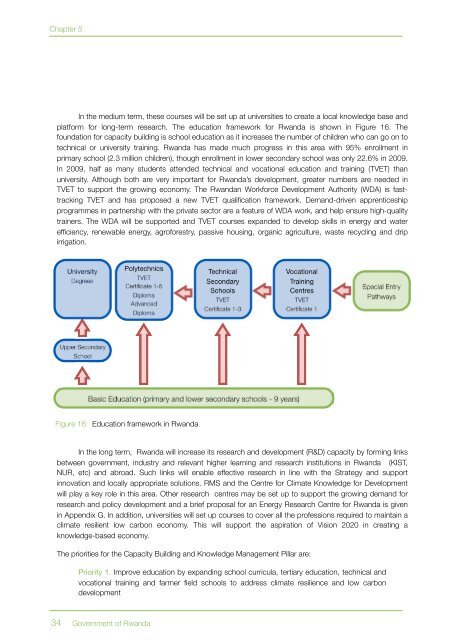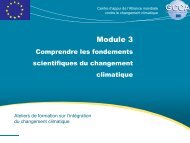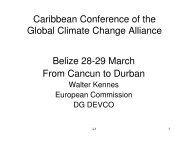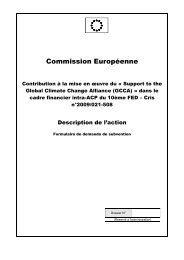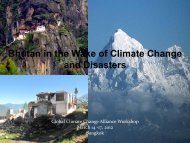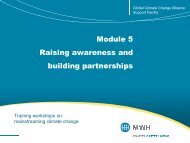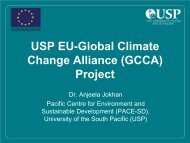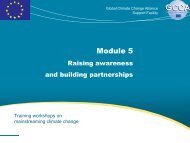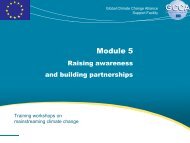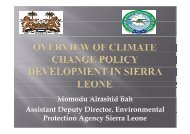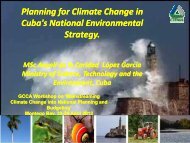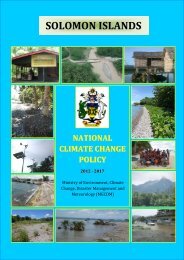Chapter 5In the medium term, these courses will be set up at universities to create a local knowledge base andplatform for long-term research. The education framework for <strong>Rwanda</strong> is shown in Figure 16. Thefoundation for capacity building is school education as it increases the number of children who can go on totechnical or university training. <strong>Rwanda</strong> has made much progress in this area with 95% enrollment inprimary school (2.3 million children), though enrollment in lower secondary school was only 22.6% in 2009.In 2009, half as many students attended technical and vocational education and training (TVET) thanuniversity. Although both are very important for <strong>Rwanda</strong>’s development, greater numbers are needed inTVET to support the growing economy. The <strong>Rwanda</strong>n Workforce Development Authority (WDA) is fasttrackingTVET and has proposed a new TVET qualification framework. Demand-driven apprenticeshipprogrammes in partnership with the private sector are a feature of WDA work, and help ensure high-qualitytrainers. The WDA will be supported and TVET courses expanded to develop skills in energy and waterefficiency, renewable energy, agroforestry, passive housing, organic agriculture, waste recycling and dripirrigation.UniversityDegreesPolytechnicsTVETCertificate 1-5DiplomaAdvancedDiplomaTechnicalSecondarySchoolsTVETCertificate 1-3VocationalTrainingCentresTVETCertificate 1Special EntryPathwaysUpper SecondarySchoolBasic Education (primary and lower secondary schools - 9 years)Figure 16: Education framework in <strong>Rwanda</strong>In the long term, <strong>Rwanda</strong> will increase its research and development (R&D) capacity by forming linksbetween government, industry and relevant higher learning and research institutions in <strong>Rwanda</strong> (KIST,NUR, etc) and abroad. Such links will enable effective research in line with the <strong>Strategy</strong> and supportinnovation and locally appropriate solutions. RMS and the Centre for <strong>Climate</strong> Knowledge for Developmentwill play a key role in this area. Other research centres may be set up to support the growing demand forresearch and policy development and a brief proposal for an Energy Research Centre for <strong>Rwanda</strong> is givenin Appendix G. In addition, universities will set up courses to cover all the professions required to maintain aclimate resilient low carbon economy. This will support the aspiration of Vision 2020 in creating aknowledge-based economy.The priorities for the Capacity Building and Knowledge Management Pillar are:Priority 1. Improve education by expanding school curricula, tertiary education, technical andvocational training and farmer field schools to address climate resilience and low carbondevelopment34Government of <strong>Rwanda</strong>
Chapter 5Priority 2. Develop capacity within national and sub-national government through exchangeprogrammes, university partnerships, training focal points, professional development and pilotvillagesPriority 3. Improve knowledge management and public awareness through an online <strong>Climate</strong>Portal, creative radio programming, short training courses, demonstrations of best practice incommunities and community exchange visitsChapter 5: Enabling PillarsPriority 4. Engage in regional and international forums and partnerships on climate andsustainable development topicsPriority 5. Ensure adequate education and training is provided for women and girlsKey responsible stakeholders are: MINEDUC, KIST, NUR, WDA, MINAGRIPillar 4. Integrated Planning and Data Management<strong>Climate</strong> change is a cross-cutting issue that impacts the economy in the long-term. Integratedplanning of multiple sector programmes is crucial due to the constraints facing <strong>Rwanda</strong>, in land, water,energy and finance. Integrated planning systems will allow the Government of <strong>Rwanda</strong> to invest in the mostefficient way, producing the maximum return on investment while accommodating different sector needs.Equally important is the collection, analysis and application of robust data across sectors. This will allowdecisions to be made based on facts and figures and will enable scenario planning. An integrated set ofanalyses is required to understand the feedbacks and interconnections between land use, ecosystemservices, water availability and energy supply going forward under future population scenarios. Theinstitutional arrangements discussed earlier will facilitate integrated planning and data management.As the population grows, the economy expands into new areas and as the climate changes, landuse will need to change. Land tenure security and a robust integrated framework for development planningand sustainable land management are essential for supporting socio-economic development. Land usemust be taken into consideration in every programme of action to ensure adaptation is embedded in thelong term. The National Land Use and Development Master Plan (NLUDMP) and subsequent District DetailPlans are the foundation for this integration. Strategic Environment Assessments (SEAs) for keyDevelopment Zones and ecologically sensitive areas need to be standard practice.<strong>Rwanda</strong> needs to develop a National Spatial Data Infrastructure (SDI) to manage the nation’s landinformation resources and to identify the fundamental data sets required to manage land and waterresources, monitor land use and environmental change, support economic development, and enable<strong>Rwanda</strong> to better plan, monitor, and respond to the impacts of climate change. The <strong>Rwanda</strong> NaturalResources Authority offers an appropriate framework to improve management of natural resource datasets. Other sectors maintain key national data sets that also must be managed, made accessible, andkept up to date. To develop its SDI, <strong>Rwanda</strong> will establish a National Information Sharing and AccessPolicy, a National SDI <strong>Strategy</strong>, a detailed national features map, and ongoing monitoring of land use andenvironmental change. Sustainable land management demands integrated analysis of various data sets including land use,zoning, administrative boundaries, roads, population and health, environment, soils and geology, hydrology,and elevation. By harnessing GIS and ICT technologies, <strong>Rwanda</strong> will enable national government anddistrict offices to avoid uncontrolled development, increased energy demand and emissions, inefficienttransport systems, over burdened water and sanitation systems, environmental degradation and loss ofbiodiversity, food insecurity, health impacts and reduced livelihoods.National <strong>Strategy</strong> on <strong>Climate</strong> <strong>Change</strong> and Low Carbon Development 35


